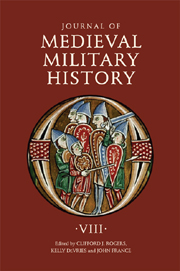Book contents
- Frontmatter
- Contents
- 1 People against Mercenaries: The Capuchins in Southern Gaul
- 2 The Last Italian Expedition of Henry IV: Re-reading the Vita Mathildis of Donizone of Canossa
- 3 Jaime I of Aragon: Child and Master of the Spanish Reconquest
- 4 Numbers in Mongol Warfare
- 5 Battlefield Medicine in Wolfram's Parzival
- 6 Battle-Seeking, Battle-Avoiding or perhaps just Battle-Willing? Applying the Gillingham Paradigm to Enrique II of Castile
- 7 Outrance and Plaisance
- 8 Guns and Goddams: Was there a Military Revolution in Lancastrian Normandy 1415–50?
- The Name of the Siege Engine trebuchet: Etymology and History in Medieval France and Britain
- Journal of Medieval Military History 1477–545
8 - Guns and Goddams: Was there a Military Revolution in Lancastrian Normandy 1415–50?
Published online by Cambridge University Press: 12 September 2012
- Frontmatter
- Contents
- 1 People against Mercenaries: The Capuchins in Southern Gaul
- 2 The Last Italian Expedition of Henry IV: Re-reading the Vita Mathildis of Donizone of Canossa
- 3 Jaime I of Aragon: Child and Master of the Spanish Reconquest
- 4 Numbers in Mongol Warfare
- 5 Battlefield Medicine in Wolfram's Parzival
- 6 Battle-Seeking, Battle-Avoiding or perhaps just Battle-Willing? Applying the Gillingham Paradigm to Enrique II of Castile
- 7 Outrance and Plaisance
- 8 Guns and Goddams: Was there a Military Revolution in Lancastrian Normandy 1415–50?
- The Name of the Siege Engine trebuchet: Etymology and History in Medieval France and Britain
- Journal of Medieval Military History 1477–545
Summary
Historians like labels and categories. In part this has been driven by the needs of pedagogy. It cannot be a coincidence that an early use of the term “La Guerre de Cent Ans” was in Chrysanthe-Ovide Desmichels' Tableau Chronologique de l'Histoire du Moyen Age published in 1823. This work was symptomatic of the expansion of schooling in early nineteenth-century France in which competitive examinations stimulated publication of aides-mémoire. Other nations followed suit. Even in the 1970s teachers in Britain were still using William Edwards' Notes on British History and Notes on European History, cribs published almost a century earlier, which crammed the heads of unsuspecting students with “the so-and-so system,” “the age of whatsit,” and “the thingummy ‘revolution’” so that it could all be spewed out again in the examination room.
Such labels and categories can be valuable communication tools. They also give shape to our research and facilitate comparison and debate. But they can operate as straightjackets and encourage tunnel vision. Take the expression “Hundred Years War.” At one level it is useful because it emphasizes the insoluble nature of Anglo-French conflict once an English king had claimed to be the rightful king of France. Yet it is also misleading since it gives the wars fought between the 1330s and 1450s an artificial unity, a problem which links to the topic of this essay. Then there is the expression, “the military revolution.”
- Type
- Chapter
- Information
- Journal of Medieval Military History , pp. 171 - 188Publisher: Boydell & BrewerPrint publication year: 2010



